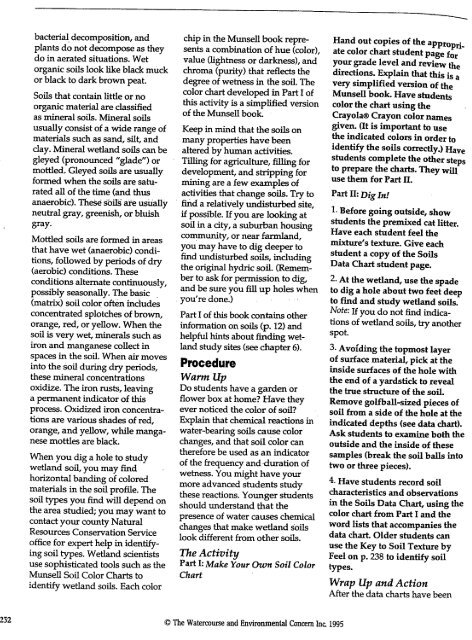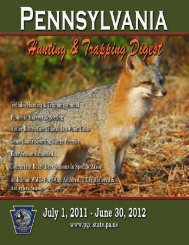You also want an ePaper? Increase the reach of your titles
YUMPU automatically turns print PDFs into web optimized ePapers that Google loves.
acterial d~omposition, and<br />
plants do not decompose as they<br />
do in aerated situations. Wet<br />
organic soils look like black muck<br />
or black to dark brown peat.<br />
<strong>Soil</strong>s that contain little or no<br />
organic material are classified<br />
as mineral soils. Mineral soils<br />
usually consist of a wide range of<br />
materials such as sand, silt, and<br />
clay. Mineral wetland soils can be<br />
gleyed (pronounced “glade”) or<br />
mottled. Gleyed soils are usually<br />
formed when the soils are saturated<br />
all of the time (and thus<br />
anaerobic). These soils are usually<br />
neutral gray, greenish, or bluish<br />
gray.<br />
Mottled soils are formed in areas<br />
that have wet (anaerobic) conditions,<br />
followed by periods of dry<br />
(aerobic) conditions. These<br />
conditions alternatecontinuously,<br />
possibly seasonally. The basic<br />
(matrix) soil coloroften includes<br />
concentrated splotches of brown,<br />
orange, red, or yellow. When the<br />
soil is very wet, minerals such as<br />
iron and manganesecollect in<br />
spaces in the soil. When air moves<br />
into the soil during dry periods,<br />
these mineral concentrations<br />
oxidize. The iron rusts, leaving<br />
a permanent indicator of this<br />
process. Oxidized iron concentrations<br />
are various shades of red,<br />
orange, and yellow, while manganese<br />
mottles are black.<br />
When you dig a hole to study<br />
wetland soil, you may find<br />
horizontal banding of colored<br />
materials in the soil profile. The<br />
soil types you find will depend on<br />
the area studied; youmay want to<br />
contactyour county Natural<br />
Resources Conservation Service<br />
office for expert help in identifying<br />
soil types. <strong>Wetland</strong> scientists<br />
use sophisticated tools such as the<br />
Munsell <strong>Soil</strong> Color Charts to<br />
identify wetland soils. Each color<br />
chip in the Munsell book represents<br />
a combination of hue (color),<br />
value (lightness or darkness), and<br />
chroma (purity) that reflects the<br />
degree of wetness in the soil. The<br />
color chart developed in PartI of<br />
this activity is a simplified version<br />
of the Munsell book.<br />
Keep in mind that the soils on<br />
many properties havebeen<br />
alteredby human activities.<br />
Tilling for agriculture, filling for<br />
development, andshipping for<br />
mining are afew examples of<br />
activities that change soils. Tryto<br />
find a relatively undisturbed site,<br />
ifpossible. If you are lookingat<br />
soil in a city, a suburban housing<br />
community, or near farmland,<br />
you may have to dig deeper to<br />
find undisturbed soils, including<br />
the original hydric soil. (Remember<br />
to ask for permission to dig,<br />
and be sure you fill up holes when<br />
you’re done.)<br />
PartI of this book contains other<br />
information on soils (p. 12) and<br />
helpful hints about finding wet-<br />
land studysites (see chapter 6).<br />
Procedure<br />
Warm Up<br />
<strong>Do</strong> students have a garden or<br />
flower box athome? Have they<br />
ever noticed the color of soil?<br />
Explain that chemical reactions in<br />
water-bearing soils cause color<br />
changes, and that soil color can<br />
therefore be used as an indicator<br />
of the frequencyand duration of<br />
wetness. <strong>You</strong> might have your<br />
more advanced students study<br />
these reactions. <strong>You</strong>nger students<br />
should understand that the<br />
presence of water causes chemical<br />
changes that makewetland soils<br />
look different from other soils.<br />
The Activity<br />
Part I: Make <strong>You</strong>r Own <strong>Soil</strong> Color<br />
Chart<br />
232 © The Watercourse and Envirozunental Concern Inc. jg95<br />
Hand out copies of the approp~<br />
ate color chartstudent page for<br />
your grade level and reviewthe<br />
directions. Explain that this is a<br />
very simpiffied version of the<br />
Munseil book. Have students<br />
color the chart using the<br />
Crayola® Crayon colornames<br />
given. (It is important to use<br />
the indicated colors in order to<br />
identify the soils correctly.) Have<br />
students complete the other steps<br />
to prepare the charts. Theywifl<br />
use them for Part II.<br />
Part II: <strong>Dig</strong> In!<br />
I. Before going outside, show<br />
students the premixed cat litter.<br />
Have each student feel the<br />
mixture’s texture. Give each<br />
student a copy of the <strong>Soil</strong>s<br />
Data Chart studentpage.<br />
2. At the wetland, use the spade<br />
to dig a hole abouttwo feet deep<br />
to find and study wetland soils.<br />
Note: Ifyou do not find indications<br />
of wetland soils, try another<br />
spot.<br />
3. Avoiding the topmost layer<br />
of surface material, pick at the<br />
inside surfaces of the hole with<br />
the end of a yardstick to reveal<br />
the true structure of the soil.<br />
Remove golfbail-sized pieces of<br />
soil from a side of the hole at the<br />
indicated depths (see data chart).<br />
Ask students to examine both the<br />
outside and the inside of these<br />
samples (break the soil balls into<br />
two or three pieces).<br />
4. Have students record soil<br />
characteristics and observations<br />
in the <strong>Soil</strong>s Data Chart, using the<br />
color chart from Part I and the<br />
word lists that accompanies the<br />
data chart. Older students can<br />
use the Key to <strong>Soil</strong> Texture by<br />
Feel on p. 238 to identify soil<br />
types.<br />
Wrap Up and Action<br />
After the data charts havebeen



